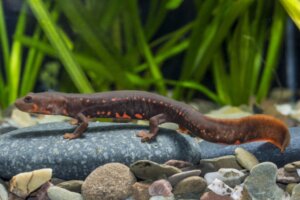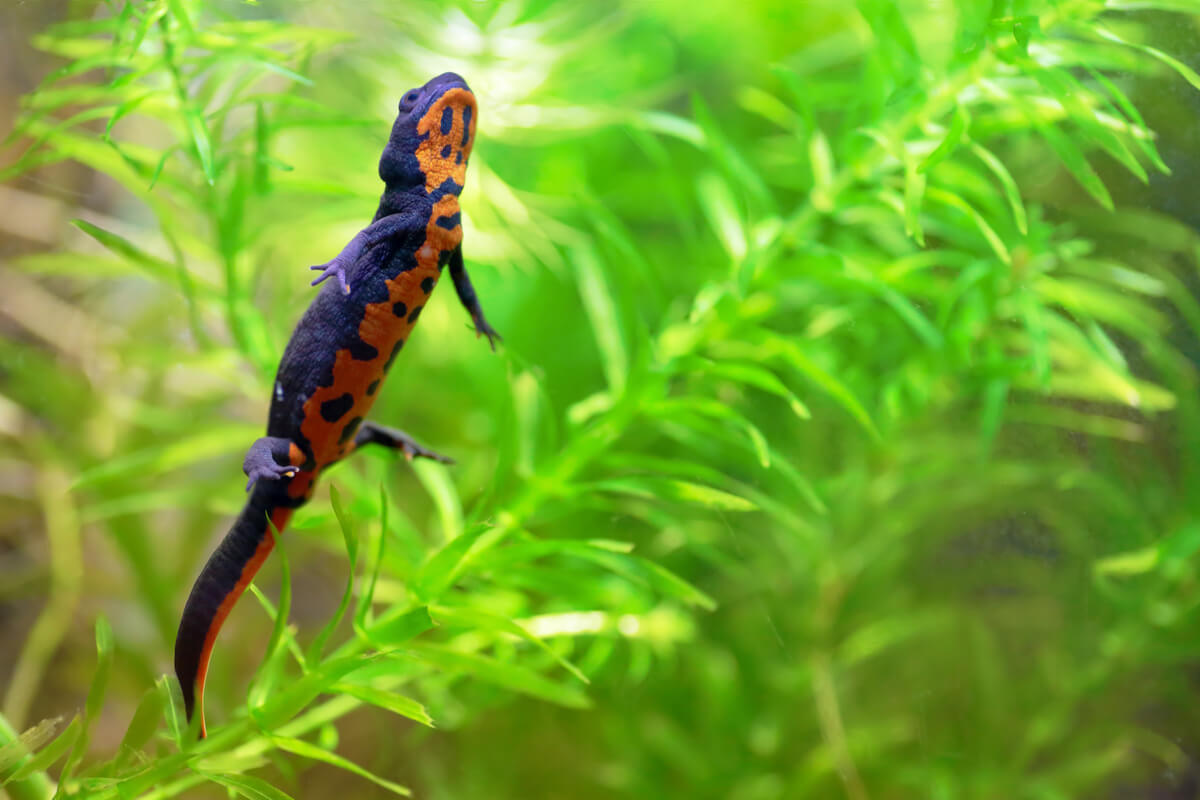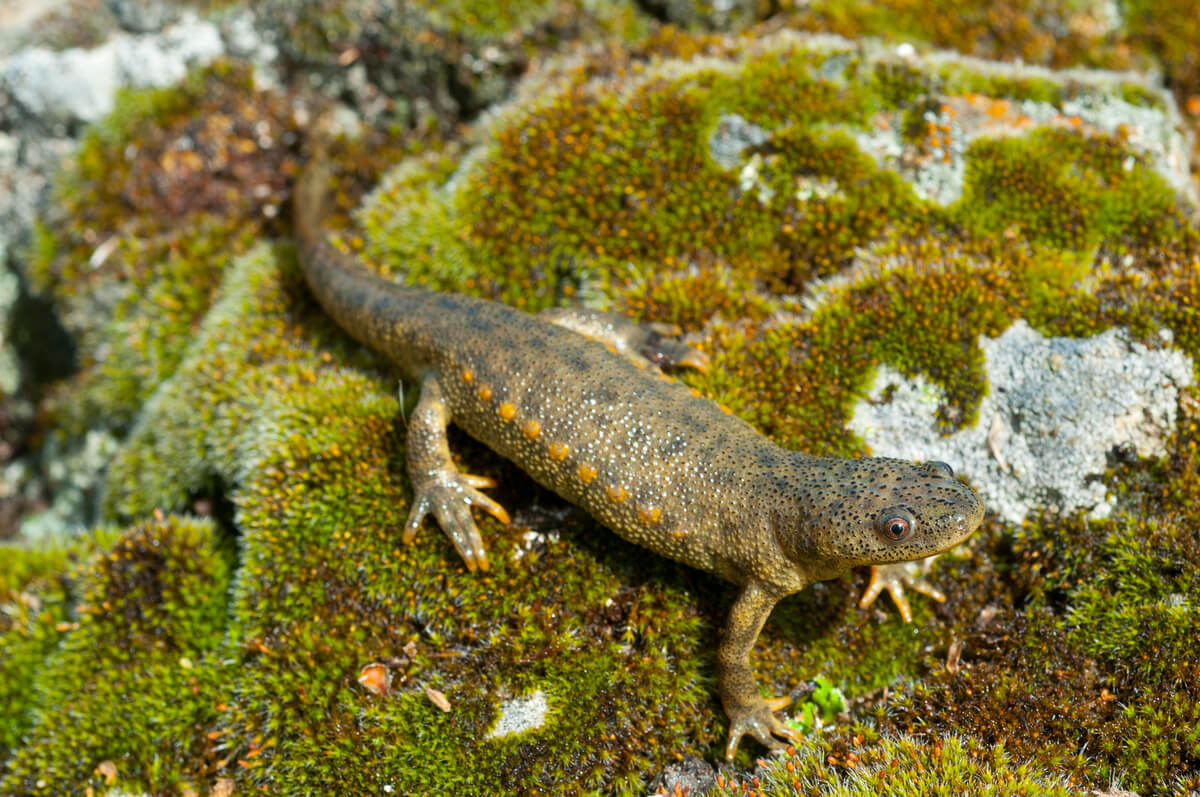10 Curiosities About Newts


Written and verified by the biologist Samuel Sanchez
There are many fascinating curiosities about newts, as, like frogs and toads, they have become used to living both on land and in water. These animals usually have a complex type of reproduction, they have a tail that helps them swim, and they feed on aquatic insects (among other invertebrates).
Although they’re often used as interchangeable terms, newt and salamander aren’t the same. These animals have their own traits which they don’t share with any other amphibian, in addition to having a certain kinship between them. Discover the world of these amphibians, as we show you 10 curiosities about newts.
1. Newts are amphibians
Newts belong to the Amphibia class, which also includes frogs, toads, salamanders, and caecilians. Although 88% of amphibians are anurans (frogs), it should be noted that those belonging to the order Caudata (salamanders and newts) represent some 695 living species. They differ from other amphibians by the presence of their tails.
Newts are caudates, but not all caudates are newts. There are more than 100 species of these tailed amphibians, but they tend to differ from salamanders by their more aquatic habits and by the absence of parotoid glands behind the eyes. It’s also common for some newts to have webbed feet, which helps them swim.
There are between 14 and 17 genera of newts alive today.
2. Delving into its taxonomic situation
Newts belong to the Salamandridae family, but they’re distinct from the rest of their relatives by being included in the Pleurodelinae subfamily. The amphibian genera known as “strict newts” are the following: Cynops, Echinotriton, Euproctus, Neurergus, Notophthalmus, Pachytriton, Paramesotriton, Pleurodeles, Taricha, Triturus and Tylototriton.
At the genetic level, salamanders belong to the genera Chioglossa, Mertensiella and Salamandra.

3. Newts inhabit very diverse places
One of the most striking characteristics of newts is their heterogeneous distribution. They can be found in the water bodies and wetlands of North America, Europe, North Africa, and Asia. Most representatives of this group are found in the Old World, as Asia is home to more than 40 of the 100 existing species.
Newts are semi-aquatic, so they require semi-permanent water sources during at least the warmest months of the year. In places like the Iberian Peninsula (where water sources dry up in autumn-winter) they can adopt a terrestrial phase that lasts for several months.
4. A series of common general characteristics
Like all amphibians, newts have 4 limbs, large mouths, striking eyes, and very thin skin. However, unlike anurans, they have a cylindrical body, generally flattened heads and a very powerful tail which helps them when swimming.
In general, newts are dark in color on the dorsal area and on their sides and have much more striking tones in their ventral section. This makes a lot of sense, as seen from above they blend in with the bottom of the body of water, while from below you can see their colors that indicate a certain toxicity.
Some newts are aposematic. They have striking shades that show their ability to produce toxins.
5. Breathing
Amphibian lungs are fairly basic, lacking the spongy structures and chambers that are present in the respiratory tract of mammals and birds. Therefore, their skin needs to help them to breathe. In some species, the epidermal oxygen exchange rate reaches up to 100% of the total.
Although they aren’t newts as such, salamanders of the genus Plethodontidae stand out from other amphibians due to their total absence of lungs. These vertebrates breathe only through the skin and through the epithelia located in the oropharyngeal cavity.
6. The secret of regeneration?
Salamander larvae of the genus Ambystoma have been used in many different experiments, as they’re capable of growing entire organs after injury. Anyway, another of the curiosities about newts is that they also have an unusual regenerative capacity.
One of the most widespread theories is that the cells of these urodels are capable of dedifferentiating, proliferating, and re-specializing to rebuild damaged tissue. Thus, instead of forming scar tissue (like humans), they’re able to replace an amputated section with another equally functional one.
7. Newts have intricate reproduction
The breeding season of newts in the northern hemisphere is between June and July, although in drier places like the Iberian Peninsula they can begin to develop the copulation instinct much earlier, around March-April. Sexual dimorphism is usually very evident, as males have calluses on the legs, ridges, and swollen cloacas.
According to studies, some newts have a reproductive behavior called lekking. In it, the males are added into the water in an orderly fashion, following a certain hierarchy. They’re exhibited as if it were a dating contest, and the females choose the most striking.
The coloration, hierarchical position, and sexual dimorphism of the male are indicative of his genetic quality.
8. Like all amphibians, they go through a larval stage
Another of the curiosities about newts is that they all have an aquatic larval stage. However, unlike frogs and toads, the hatchlings aren’t tadpole-shaped. These are more elongated, develop the limbs earlier, and have external gills in the form of a “tree”.
When the larvae metamorphose, they lose their gills, develop their lungs, and go through a terrestrial phase of variable duration.
9. These amphibians do their best
Some newts produce toxic substances from certain glands to intimidate their predators, as they’re slow, clumsy animals with few means of escape available. The Taricha granulosa species is especially notable on this front, as it produces enough tetrodotoxins to kill a human without a problem.
Other species have more rudimentary methods of defense. For example, the Iberian newt Pleurodeles waltl has a series of toxic glands throughout its body. When threatened, it sticks its own ribs over the glands and pulls them out, puncturing and intoxicating any potential predator that tries to eat it.

10. They aren’t dangerous animals but are in danger of extinction
In the last of our curiosities about newts, we need to emphasize that they aren’t dangerous for humans. Unless a person intentionally puts a specimen in their mouth or rubs their eyes after handling it, it’s impossible for its toxins to reach our body (if they carry them).
In addition, newts and 41% of amphibians, in general, are in danger of extinction, as climate change and water pollution are destroying their original habitats. It’s necessary to get to know and take care of these impressive living beings so that we can continue enjoying them for many years to come.
There are many fascinating curiosities about newts, as, like frogs and toads, they have become used to living both on land and in water. These animals usually have a complex type of reproduction, they have a tail that helps them swim, and they feed on aquatic insects (among other invertebrates).
Although they’re often used as interchangeable terms, newt and salamander aren’t the same. These animals have their own traits which they don’t share with any other amphibian, in addition to having a certain kinship between them. Discover the world of these amphibians, as we show you 10 curiosities about newts.
1. Newts are amphibians
Newts belong to the Amphibia class, which also includes frogs, toads, salamanders, and caecilians. Although 88% of amphibians are anurans (frogs), it should be noted that those belonging to the order Caudata (salamanders and newts) represent some 695 living species. They differ from other amphibians by the presence of their tails.
Newts are caudates, but not all caudates are newts. There are more than 100 species of these tailed amphibians, but they tend to differ from salamanders by their more aquatic habits and by the absence of parotoid glands behind the eyes. It’s also common for some newts to have webbed feet, which helps them swim.
There are between 14 and 17 genera of newts alive today.
2. Delving into its taxonomic situation
Newts belong to the Salamandridae family, but they’re distinct from the rest of their relatives by being included in the Pleurodelinae subfamily. The amphibian genera known as “strict newts” are the following: Cynops, Echinotriton, Euproctus, Neurergus, Notophthalmus, Pachytriton, Paramesotriton, Pleurodeles, Taricha, Triturus and Tylototriton.
At the genetic level, salamanders belong to the genera Chioglossa, Mertensiella and Salamandra.

3. Newts inhabit very diverse places
One of the most striking characteristics of newts is their heterogeneous distribution. They can be found in the water bodies and wetlands of North America, Europe, North Africa, and Asia. Most representatives of this group are found in the Old World, as Asia is home to more than 40 of the 100 existing species.
Newts are semi-aquatic, so they require semi-permanent water sources during at least the warmest months of the year. In places like the Iberian Peninsula (where water sources dry up in autumn-winter) they can adopt a terrestrial phase that lasts for several months.
4. A series of common general characteristics
Like all amphibians, newts have 4 limbs, large mouths, striking eyes, and very thin skin. However, unlike anurans, they have a cylindrical body, generally flattened heads and a very powerful tail which helps them when swimming.
In general, newts are dark in color on the dorsal area and on their sides and have much more striking tones in their ventral section. This makes a lot of sense, as seen from above they blend in with the bottom of the body of water, while from below you can see their colors that indicate a certain toxicity.
Some newts are aposematic. They have striking shades that show their ability to produce toxins.
5. Breathing
Amphibian lungs are fairly basic, lacking the spongy structures and chambers that are present in the respiratory tract of mammals and birds. Therefore, their skin needs to help them to breathe. In some species, the epidermal oxygen exchange rate reaches up to 100% of the total.
Although they aren’t newts as such, salamanders of the genus Plethodontidae stand out from other amphibians due to their total absence of lungs. These vertebrates breathe only through the skin and through the epithelia located in the oropharyngeal cavity.
6. The secret of regeneration?
Salamander larvae of the genus Ambystoma have been used in many different experiments, as they’re capable of growing entire organs after injury. Anyway, another of the curiosities about newts is that they also have an unusual regenerative capacity.
One of the most widespread theories is that the cells of these urodels are capable of dedifferentiating, proliferating, and re-specializing to rebuild damaged tissue. Thus, instead of forming scar tissue (like humans), they’re able to replace an amputated section with another equally functional one.
7. Newts have intricate reproduction
The breeding season of newts in the northern hemisphere is between June and July, although in drier places like the Iberian Peninsula they can begin to develop the copulation instinct much earlier, around March-April. Sexual dimorphism is usually very evident, as males have calluses on the legs, ridges, and swollen cloacas.
According to studies, some newts have a reproductive behavior called lekking. In it, the males are added into the water in an orderly fashion, following a certain hierarchy. They’re exhibited as if it were a dating contest, and the females choose the most striking.
The coloration, hierarchical position, and sexual dimorphism of the male are indicative of his genetic quality.
8. Like all amphibians, they go through a larval stage
Another of the curiosities about newts is that they all have an aquatic larval stage. However, unlike frogs and toads, the hatchlings aren’t tadpole-shaped. These are more elongated, develop the limbs earlier, and have external gills in the form of a “tree”.
When the larvae metamorphose, they lose their gills, develop their lungs, and go through a terrestrial phase of variable duration.
9. These amphibians do their best
Some newts produce toxic substances from certain glands to intimidate their predators, as they’re slow, clumsy animals with few means of escape available. The Taricha granulosa species is especially notable on this front, as it produces enough tetrodotoxins to kill a human without a problem.
Other species have more rudimentary methods of defense. For example, the Iberian newt Pleurodeles waltl has a series of toxic glands throughout its body. When threatened, it sticks its own ribs over the glands and pulls them out, puncturing and intoxicating any potential predator that tries to eat it.

10. They aren’t dangerous animals but are in danger of extinction
In the last of our curiosities about newts, we need to emphasize that they aren’t dangerous for humans. Unless a person intentionally puts a specimen in their mouth or rubs their eyes after handling it, it’s impossible for its toxins to reach our body (if they carry them).
In addition, newts and 41% of amphibians, in general, are in danger of extinction, as climate change and water pollution are destroying their original habitats. It’s necessary to get to know and take care of these impressive living beings so that we can continue enjoying them for many years to come.
All cited sources were thoroughly reviewed by our team to ensure their quality, reliability, currency, and validity. The bibliography of this article was considered reliable and of academic or scientific accuracy.
- Hedlund, L., & Robertson, J. G. (1989). Lekking behaviour in crested newts, Triturus cristatus. Ethology, 80(1‐4), 111-119.
- Zhang, P., Papenfuss, T. J., Wake, M. H., Qu, L., & Wake, D. B. (2008). Phylogeny and biogeography of the family Salamandridae (Amphibia: Caudata) inferred from complete mitochondrial genomes. Molecular phylogenetics and evolution, 49(2), 586-597.
- Oberpriller, J. O., & Oberpriller, J. C. (1974). Response of the adult newt ventricle to injury. Journal of Experimental Zoology, 187(2), 249-259.
- Oldham, R. S., Keeble, J., Swan, M. J. S., & Jeffcote, M. (2000). Evaluating the suitability of habitat for the great crested newt (Triturus cristatus). Herpetological Journal, 10(4), 143-155.
This text is provided for informational purposes only and does not replace consultation with a professional. If in doubt, consult your specialist.








